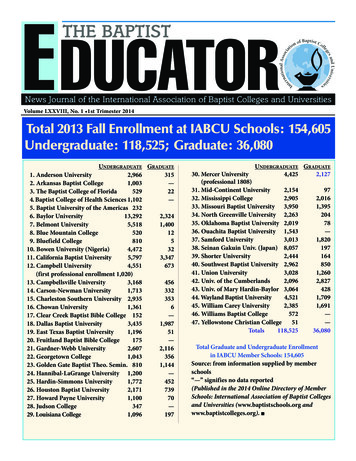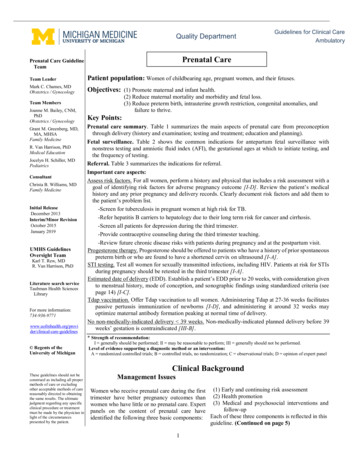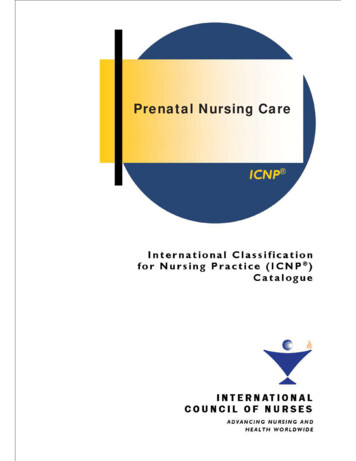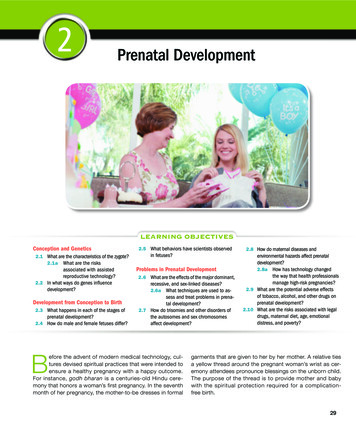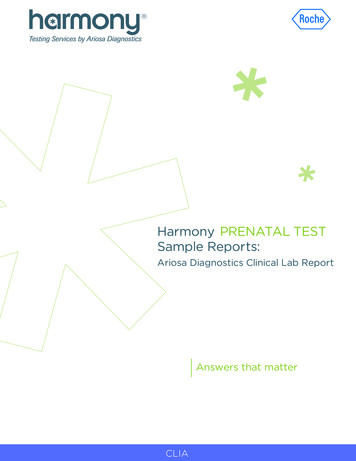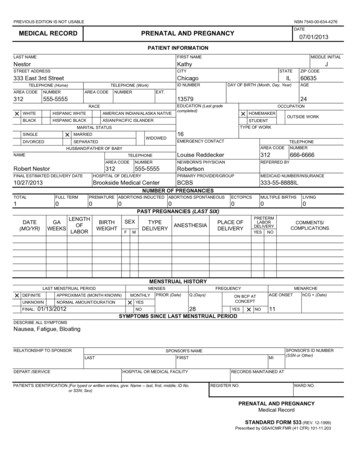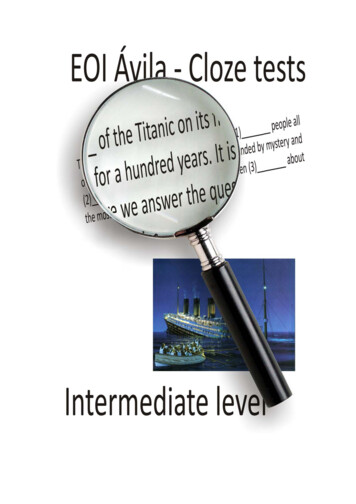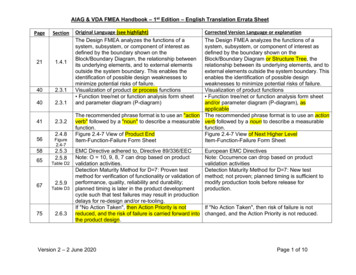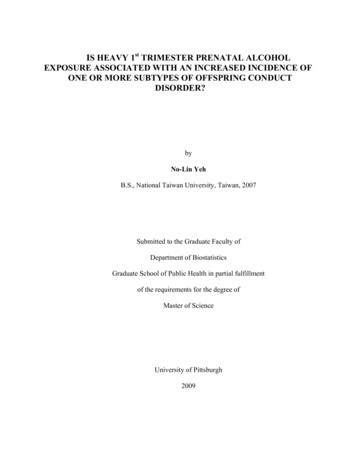
Transcription
IS HEAVY 1st TRIMESTER PRENATAL ALCOHOLEXPOSURE ASSOCIATED WITH AN INCREASED INCIDENCE OFONE OR MORE SUBTYPES OF OFFSPRING CONDUCTDISORDER?byNo-Lin YehB.S., National Taiwan University, Taiwan, 2007Submitted to the Graduate Faculty ofDepartment of BiostatisticsGraduate School of Public Health in partial fulfillmentof the requirements for the degree ofMaster of ScienceUniversity of Pittsburgh2009
UNIVERSITY OF PITTSBURGHGraduate School of Public HealthThis thesis was presentedbyNo-Lin YehIt was defended onJune 12, 2009and approved byThesis Advisor:Richard D. Day, PhDAssociate Professor, BiostatisticsAssistant Professor, Infectious Diseases and MicrobiologyGraduate School of Public HealthAssistant Professor, AnthropologySchool of Art and SciencesUniversity of PittsburghCommittee Members:Jennifer A. Willford, PhDAssistant Professor, PsychiatrySchool of MedicineUniversity of PittsburghWestern Psychiatric Institute and ClinicJohn W. Wilson, PhDAssistant Professor, BiostatisticsGraduate School of Public HealthUniversity of Pittsburghii
Copyright by No-Lin Yeh2009iii
Richard D. Day, Ph.D.IS HEAVY 1st TRIMESTER PRENATAL ALCOHOLEXPOSURE ASSOCIATED WITH AN INCREASED INCIDENCE OFONE OR MORE SUBTYPES OF OFFSPRING CONDUCTDISORDER?No-Lin Yeh, M.S.University of Pittsburgh, 2009ABSTRACTChildren with prenatal alcohol exposure (PAE) tend to show higher rates of conduct disorder(CD), even after the effect of some potentially confounding factors, including parentalalcoholism, parental drug abuse, and externalizing disorder, have been taken into account. It isclear that some subgroups of CD may show distinct developmental pathways; for instance, theuse of construct of psychopath for subtyping CD children has grown and some research hashighlighted a distinction between callous-unemotional traits and highly-impulsive traits. As moreand more studies have examined the relationship between PAE and the occurrence of CD, someimportant questions have been raised. The objective of this study is to determine whether PAE isassociated with a specific subtype of CD, or if it is equally associated with both highly impulsiveand the callous-unemotional forms of diagnosis.The National Institute of Mental Health Diagnostic Interview Schedule for Children- 4thEdition (DISC-IV) was used to assess the psychiatric disorders and symptoms of 572 childrenwith PAE. Among these 572 children, 67 met the criteria for lifetime diagnosis of CD. Wecollapsed these children into three groups based on the levels of PAE (unexposed, lightlyiv
exposed, heavy exposed). The analyses were conducted to examine the difference of each CDsymptoms and clinical information of children.The results suggest that while most of the CD symptoms and clinical information were similaramong three groups, the differences of both domains of social impairment and psychiatrictreatment in the twelve months preceding the diagnostic interview were statistically significant.Based on the outcome of the analyses, 1ST trimester PAE is associated with an observableincrease in the incidence of both callous-unemotional and highly-impulsive subtypes of childrenwith CD, rather than being associated with one or the other of these two subtypes. We wouldconclude that the CD children with PAE or non-PAE show a similar range of clinical symptomsand subtypes. For public health significance, this might be helpful information for clinicians andpublic health officials when they discuss the diagnoses or issues about children with PAE. Thisinformation may also assist researchers to build an individual and comprehensive interventionfor different subtypes of conduct disorder in children.v
TABLE OF CONTENTSACKNOWLEGEMENT. XI1.0INTRODUCTION. 11.1BACKGROUND . 11.2CONDUCT DISORDER (CD). 21.3PRENATAL ALCOHOL EXPOSURE (PAE) . 41.4HYPOTHESIS . 62.0METHOD . 72.1STUDY DESIGN . 72.2SUBJECT SELECTION . 82.3SUBJECT DESCRIPTION. 92.4MEASURE . 92.5DATA ANALYSIS. 133.0RESULTS . 163.1SYMPTOM FREQUENCY, COUNT AND MAXIMUM SEVERITY . 163.2IMPAIRMENT . 183.3AGE AT ONSET OF SYMPTOMS. 203.4ILLNESS COURSE. 213.5CURRENT STATE . 23vi
4.03.6TREATMENT. 233.7CO-MORBID DIAGNOSES. 25DISCUSSION . 27BIBLIOGRAPHY . 33vii
LIST OF TABLESTable 1. Conduct Disorder (CD) Incidence Rates in n 572 Offspring by Gender and PrenatalAlcohol Exposure (PAE) During the 1st Trimester of Pregnancy. 12Table 2. The Severity Rank of the Symptoms . 14Table 3. Frequency (over the lifetime) of Symptom Endorsement among Conduct DisorderedChildren by Prenatal Alcohol Exposure (PAE) Group . 16Table 4. Number of Maximum Endorsement Frequency (MEF) among Conduct DisorderedChildren by Prenatal Alcohol Exposure (PAE) Group . 17Table 5. Distribution of Symptom Counts and Symptom with Maximum Severity amongConduct Disordered Children by Prenatal Alcohol Exposure (PAE) Group. 17Table 6. Number of Areas of Impairment among Conduct Disordered Children by PrenatalAlcohol Exposure (PAE) Group . 18Table 7. Mean and median Age at Illness Onset for Childhood and Adolescent Onsets by 1STTrimester Prenatal Alcohol Exposure Groups . 21Table 8. Number of Episodes and Remission among Conduct Disordered Children by PrenatalAlcohol Exposure (PAE) Group . 22Table 9. Distribution of Illness Course Variable for Conduct Disorder Subjects by 1st TrimesterPrenatal Alcohol Group . 22viii
Table 10. Current Clinical State of Conduct Disordered Subjects at the 16 Year Follow-Up by 1stTrimester Prenatal Alcohol Group . 23Table 11. Treatment for Conduct Disorder or Other DSM-IV Diagnosis (Lifetime and Last Year)by 1st Trimester Prenatal Alcohol Group . 24Table 12. Proportion of Conduct Disorder Subjects with Co-Morbid Diagnoses by DiagnosticCategory and 1st Trimester Prenatal Alcohol Group . 25ix
LIST OF FIGURESFigure 1. Proportion of Subjects in Each 1st Trimester Prenatal Alcohol Group EndorsingDifferent Domains of Social Impairment . 19Figure 2. Proportion of Subject in Each Prenatal Alcohol Exposure Group Onset Illness . 20Figure 3. Number Co-Morbid Diagnoses among Conduct Disordered Children by PrenatalAlcohol Exposure Groups . 26x
ACKNOWLEGEMENTI would like to express my sincere gratitude to my thesis and academic advisor Dr. RichardDay for his constant support, guidance, encouragement and invaluable input throughout thepreparation of this thesis and the duration of my graduate studies. Dr. Day, thank you for yourtime and patience, I have learned so much from you throughout my master's program.I also want to express my appreciation to Dr. Jennifer Willford for her assistance and guidancein researching prenatal alcohol exposure and psychiatric terminology. Dr. Willford, thank you somuch for the insightful comments you contributed to my study. I would also like to thank Dr.John Wilson for his time, valuable suggestions and useful statistical methods.I would like to thank WPIC groups especially Mrs. Jhon Young, for her assistance inexplaining the variables in this study.Finally, I would also like to thank my family and friends for their love, care, encouragementand endless support. Thank you.xi
1.0 INTRODUCTION1.1BACKGROUNDIn a number of population-based epidemiological studies (Larkby and Day 1997; Hill, Lowerset al. 2000; Fryer, McGee et al. 2007; Disney, Iacono et al. 2008; Staroselsky, Fantus et al.2009), researchers demonstrated that children or adolescents with prenatal alcohol exposure(PAE) have an elevated risk of conduct disorder (CD). The studies show that PAE is animportant and independent risk factor for predicting CD, and that it has an association with CDdiagnosis. According to previous studies (Fryer, McGee et al. 2007; Staroselsky, Fantus et al.2009), about 90% of individuals with PAE have psychiatric problems, including AttentionDeficit Hyperactivity Disorder (ADHD), depression, bipolar disorder or CD. Recent studies(Larkby and Day 1997; Disney, Iacono et al. 2008) further indicated that PAE had a direct effecton the rates of CD, even after the effect of some potentially confounding factors, includingparental alcoholism, parental drug abuse, and externalizing disorder, have been taken intoaccount.1
1.2CONDUCT DISORDER (CD)CD is a form of childhood psychopathology in which the child repetitively and persistentlyviolates the basic rights of other or major age-appropriate societal norms or rules (Frick 2006).Based on the Diagnostic and Statistical Manual of Mental Disorders 4th Edition (DSM-IV)diagnostic criteria for CD, children who meet the criteria for CD must demonstrate at least threeof the following behaviors over the previous 12 months, with at least one criterion present in thepast six months: (1) Aggression toward people and/or animals: often bullies, threatens,intimidates others, initiates physical flights, uses weapons to cause serious physical harm toothers, shows physically cruelly toward people and animals, steals while confronting a victim,forces people into sexual activity. (2) Destruction of property: deliberately engages in fire tocause serious damage, deliberately destroys others’ property. (3) Deceitfulness or theft: breaksinto someone else’s house, building or car, lies to obtain good or favor or to avoid obligations.(4) Serious violation of rules: stays out at night against parents wish before age 13, runs awayfrom home overnight, often truants from school (Sterzer, Stadler et al. 2005; Frick 2006; Frickand Dickens 2006; Vloet, Konrad et al. 2008).Studies show that there are several risk factors for CD. The risk factors include characteristicsof the child (neuropsychological deficits, autonomic irregularities, and temperamental traits),family history of mental health disorders, low socioeconomic status, poor parenting, parentalalcoholism, peer rejection and neighborhood disorganization (Frick and Dickens 2006; Frick andWhite 2008).It has also became clear that there are subgroups of CD that may show distinct causalprocesses (Dandreaux and Frick 2009). Nowadays, the use of the construct of psychopathy for2
subtyping CD children has grown, and some research has highlighted a useful distinctionbetween callous-unemotional traits and highly-impulsive traits (Dolan 2008; Dandreaux andFrick 2009). Children with callous-unemotional traits are the main demographic of childhoodonset group (Langbehn and Cadoret 2001; Frick 2006), which had their first symptoms beforeage 10 and tend to show persistently higher rates of neuropsychological dysfunction (Moffitt1993; Moffitt and Lynam 1994; Frick and Ellis 1999; Dandreaux and Frick 2009). Children inthis subtype seem to show severe and aggressive patterns of behavior(Frick 2006), a lack ofempathy and guilt, and are more persistent and less reactive to threatening and emotional stimuli(Vloet, Konrad et al. 2008). Children in the highly-impulsive subtype are more associated withadulthood-onset group, who had their first CD symptom after age 10 (Dolan 2008; Frick andWhite
Assistant Professor, Psychiatry . School of Medicine . University of Pittsburgh . Western Psychiatric Institute and Clinic . John W. Wilson, PhD . Assistant Professor, Biostatistics . Graduate School of Public Health . University of Pittsburgh . ii
